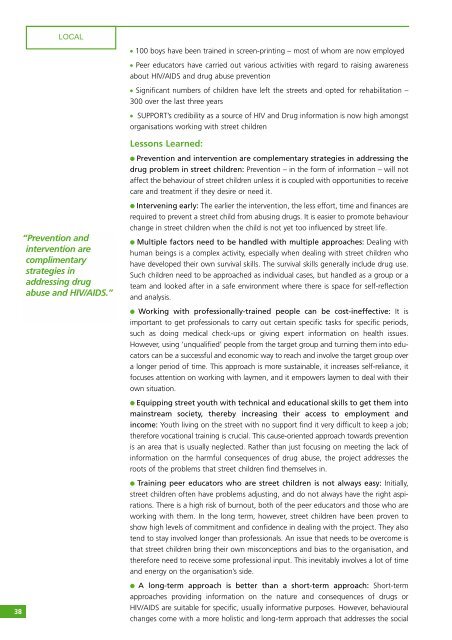PDF (Lessons learned in drug abuse prevention: a global review)
PDF (Lessons learned in drug abuse prevention: a global review)
PDF (Lessons learned in drug abuse prevention: a global review)
You also want an ePaper? Increase the reach of your titles
YUMPU automatically turns print PDFs into web optimized ePapers that Google loves.
LOCAL<br />
● 100 boys have been tra<strong>in</strong>ed <strong>in</strong> screen-pr<strong>in</strong>t<strong>in</strong>g – most of whom are now employed<br />
● Peer educators have carried out various activities with regard to rais<strong>in</strong>g awareness<br />
about HIV/AIDS and <strong>drug</strong> <strong>abuse</strong> <strong>prevention</strong><br />
● Significant numbers of children have left the streets and opted for rehabilitation –<br />
300 over the last three years<br />
● SUPPORT’s credibility as a source of HIV and Drug <strong>in</strong>formation is now high amongst<br />
organisations work<strong>in</strong>g with street children<br />
<strong>Lessons</strong> Learned:<br />
● Prevention and <strong>in</strong>tervention are complementary strategies <strong>in</strong> address<strong>in</strong>g the<br />
<strong>drug</strong> problem <strong>in</strong> street children: Prevention – <strong>in</strong> the form of <strong>in</strong>formation – will not<br />
affect the behaviour of street children unless it is coupled with opportunities to receive<br />
care and treatment if they desire or need it.<br />
“Prevention and<br />
<strong>in</strong>tervention are<br />
complimentary<br />
strategies <strong>in</strong><br />
address<strong>in</strong>g <strong>drug</strong><br />
<strong>abuse</strong> and HIV/AIDS.”<br />
● Interven<strong>in</strong>g early: The earlier the <strong>in</strong>tervention, the less effort, time and f<strong>in</strong>ances are<br />
required to prevent a street child from abus<strong>in</strong>g <strong>drug</strong>s. It is easier to promote behaviour<br />
change <strong>in</strong> street children when the child is not yet too <strong>in</strong>fluenced by street life.<br />
● Multiple factors need to be handled with multiple approaches: Deal<strong>in</strong>g with<br />
human be<strong>in</strong>gs is a complex activity, especially when deal<strong>in</strong>g with street children who<br />
have developed their own survival skills. The survival skills generally <strong>in</strong>clude <strong>drug</strong> use.<br />
Such children need to be approached as <strong>in</strong>dividual cases, but handled as a group or a<br />
team and looked after <strong>in</strong> a safe environment where there is space for self-reflection<br />
and analysis.<br />
● Work<strong>in</strong>g with professionally-tra<strong>in</strong>ed people can be cost-<strong>in</strong>effective: It is<br />
important to get professionals to carry out certa<strong>in</strong> specific tasks for specific periods,<br />
such as do<strong>in</strong>g medical check-ups or giv<strong>in</strong>g expert <strong>in</strong>formation on health issues.<br />
However, us<strong>in</strong>g ‘unqualified’ people from the target group and turn<strong>in</strong>g them <strong>in</strong>to educators<br />
can be a successful and economic way to reach and <strong>in</strong>volve the target group over<br />
a longer period of time. This approach is more susta<strong>in</strong>able, it <strong>in</strong>creases self-reliance, it<br />
focuses attention on work<strong>in</strong>g with laymen, and it empowers laymen to deal with their<br />
own situation.<br />
● Equipp<strong>in</strong>g street youth with technical and educational skills to get them <strong>in</strong>to<br />
ma<strong>in</strong>stream society, thereby <strong>in</strong>creas<strong>in</strong>g their access to employment and<br />
<strong>in</strong>come: Youth liv<strong>in</strong>g on the street with no support f<strong>in</strong>d it very difficult to keep a job;<br />
therefore vocational tra<strong>in</strong><strong>in</strong>g is crucial. This cause-oriented approach towards <strong>prevention</strong><br />
is an area that is usually neglected. Rather than just focus<strong>in</strong>g on meet<strong>in</strong>g the lack of<br />
<strong>in</strong>formation on the harmful consequences of <strong>drug</strong> <strong>abuse</strong>, the project addresses the<br />
roots of the problems that street children f<strong>in</strong>d themselves <strong>in</strong>.<br />
● Tra<strong>in</strong><strong>in</strong>g peer educators who are street children is not always easy: Initially,<br />
street children often have problems adjust<strong>in</strong>g, and do not always have the right aspirations.<br />
There is a high risk of burnout, both of the peer educators and those who are<br />
work<strong>in</strong>g with them. In the long term, however, street children have been proven to<br />
show high levels of commitment and confidence <strong>in</strong> deal<strong>in</strong>g with the project. They also<br />
tend to stay <strong>in</strong>volved longer than professionals. An issue that needs to be overcome is<br />
that street children br<strong>in</strong>g their own misconceptions and bias to the organisation, and<br />
therefore need to receive some professional <strong>in</strong>put. This <strong>in</strong>evitably <strong>in</strong>volves a lot of time<br />
and energy on the organisation’s side.<br />
38<br />
● A long-term approach is better than a short-term approach: Short-term<br />
approaches provid<strong>in</strong>g <strong>in</strong>formation on the nature and consequences of <strong>drug</strong>s or<br />
HIV/AIDS are suitable for specific, usually <strong>in</strong>formative purposes. However, behavioural<br />
changes come with a more holistic and long-term approach that addresses the social
















